Master Cylinder Overhaul 1.6L Non-ABS
Disassembly Procedure
Caution: Wear safety glasses in order to avoid eye damage.
Caution: Brake fluid may irritate eyes and skin. In case of contact, take the
following actions:
• Eye contact--rinse thoroughly with water. • Skin contact--wash with soap and water. • If ingested--consult a physician immediately.
Caution: Use only Delco Supreme 11, GM P/N 12377967 (Canadian P/N 992667), or equivalent DOT 3 brake fluid from a clean, sealed container. Do not use fluid from an open container that may be contaminated with water. Improper or contaminated fluid could result in damage to components, or loss of braking, with possible injury.
Notice: When filling the master cylinder, use only Delco Supreme 11, GM P/N 12377967 (Canadian P/N 992667), or equivalent DOT 3 brake fluid. Do not use a container which has been used for petroleum based fluids, or a container which is wet with water. Petroleum based fluids will cause swelling and distortion of rubber parts in the hydraulic brake system, and water will mix with brake fluid, lowering the boiling point. Keep all fluid containers capped to prevent contamination.
Notice: Do not hone the master cylinder bore. When the brake master cylinder is overhauled, it is recommended that the cylinder body be replaced rather than CLEANED UP by honing the bore. The master cylinder has a hard, highly polished BEARINGIZED surface, which is produced by diamond boring followed by ball or roller burnishing under heavy pressure. Honing will destroy this hard smooth surface and cause rapid wear of the rubber cups.
Notice: Do not clamp on the master cylinder body. Doing so may damage the master cylinder.
- Remove the reservoir (3) from the master cylinder (5). Refer to Master Cylinder Reservoir Replacement .
- Remove the master cylinder from the booster. Refer to Master Cylinder Replacement .
- Remove the snap ring (1) from the master cylinder (2).
- Remove the plate.
- Remove the piston guide with the O-rings.
- Remove the piston stopper.
- Pull the primary piston assembly carefully from the master cylinder in order to prevent damage to the inside of the cylinder wall.
- Remove the primary piston cup.
- Remove the piston stopper bolt and the washer from the master cylinder.
- Remove the secondary piston assembly by blowing compressed air into the stopper bolt hole (2).
- Remove the piston cup and the secondary piston pressure cup.
- Remove the spring.
- Remove the O-ring.
- Inspect the components for wear or damage. Replace the components if necessary.
- Wash disassembled parts with brake fluid.
- Inspect the master cylinder bore for scoring or corrosion. Replace a damaged master cylinder.
- Rinse the cylinder in clean brake fluid. Shake excess rinsing fluid from the cylinder.

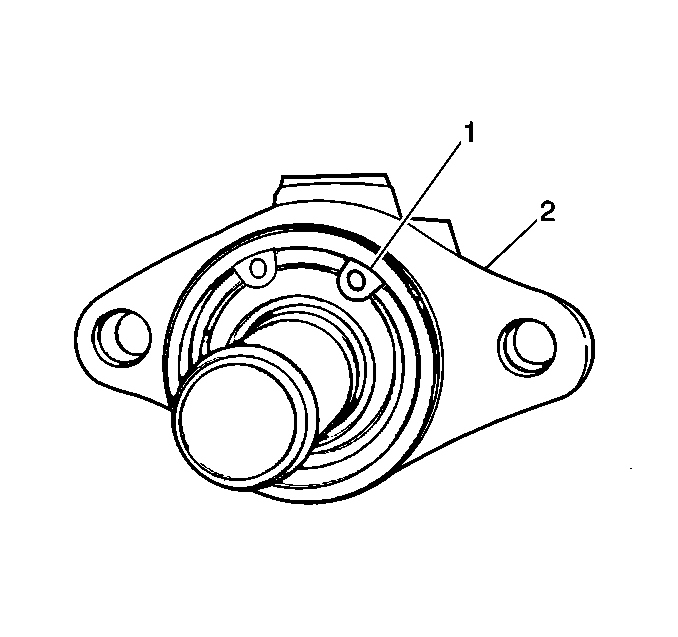
Caution: Do not place your fingers in front of the piston in order to catch or protect the piston while applying compressed air. This could result in serious injury.
Notice: Do not use lubricated compressed air on brake parts as damage to rubber components may result.
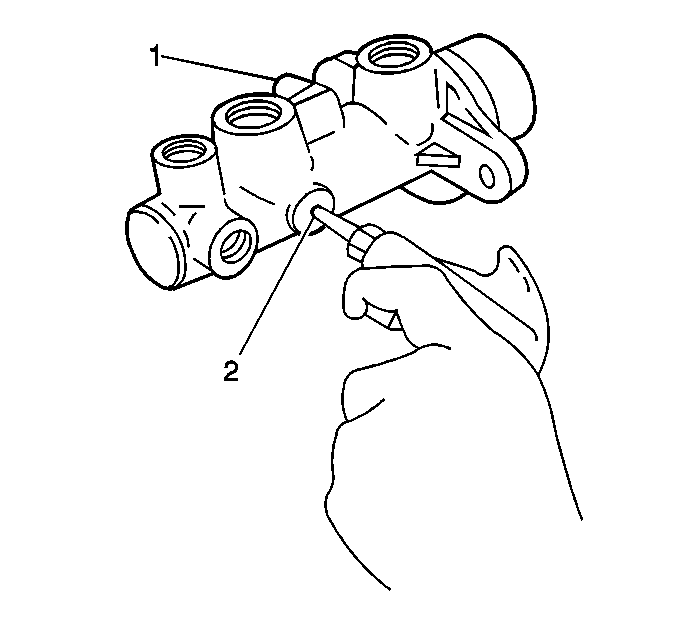
Important: DO NOT reuse piston cups.
Important: DO NOT use a cloth in order to dry the cylinder, because lint from a cloth will stick to the cylinder bore surfaces.
Assembly Procedure
- Install the O-ring to the master cylinder (2).
- Install the spring.
- Install the following into the master cylinder:
- Install the following into the master cylinder:
- Install the new piston stopper.
- Install the piston guide and the O-rings.
- Install the plate.
- Depress and install the snap ring (1).
- With the pistons pushed entirely inside the cylinder, install the piston stopper bolt.
- Install the master cylinder to the brake booster. Refer to Master Cylinder Replacement .
- Apply a thin coat of brake fluid around the new grommets (4), and install the new grommets to the master cylinder (5).
- Install the reservoir. Refer to Master Cylinder Reservoir Replacement .
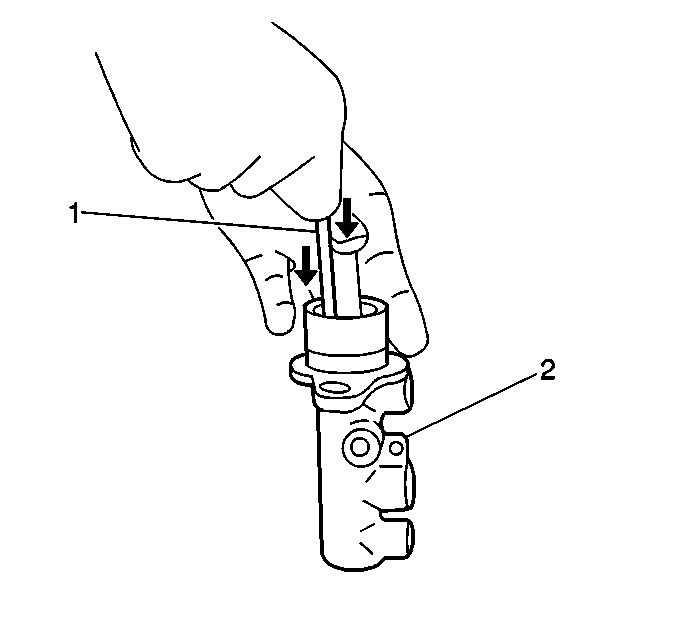
| • | The secondary piston assembly |
| • | The new piston cup |
| • | The new secondary piston pressure cup |
| • | The primary piston |
| • | The new primary piston cup |
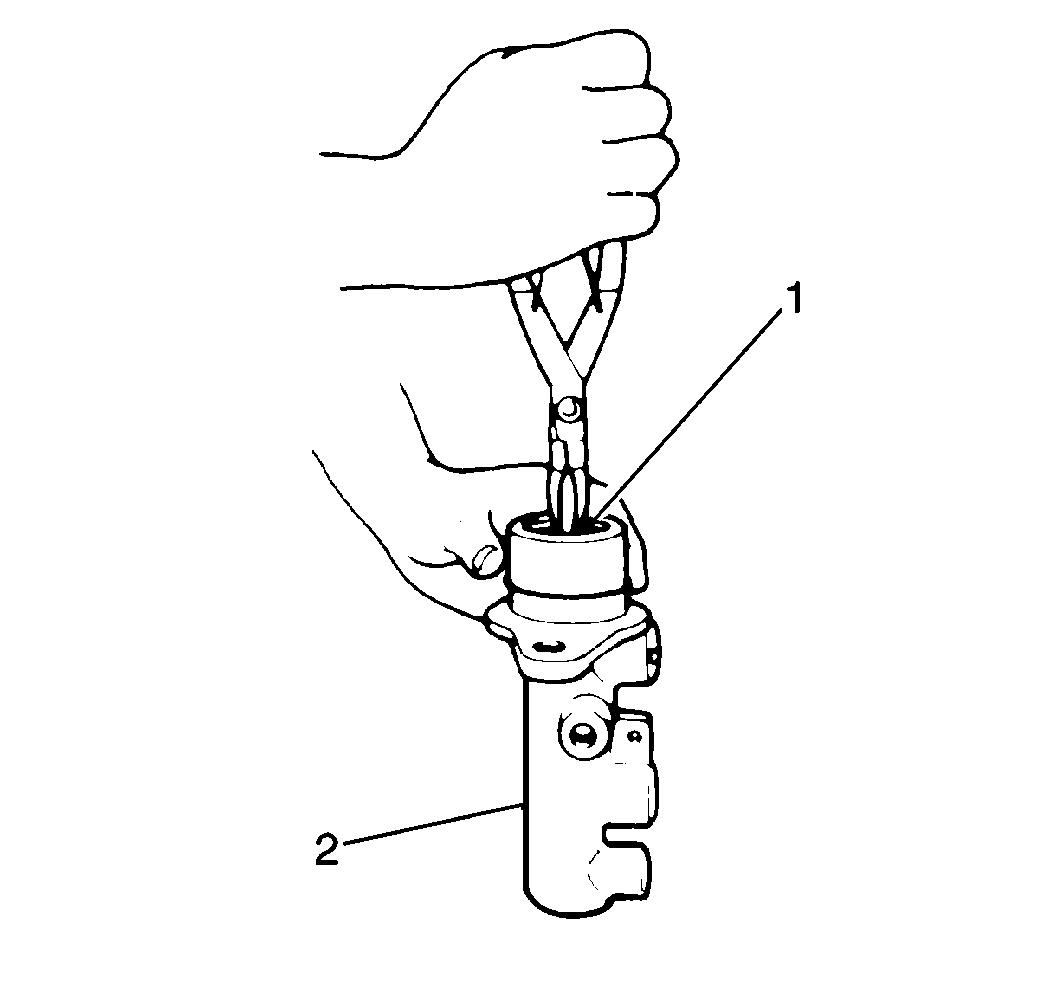
Notice: Use the correct fastener in the correct location. Replacement fasteners must be the correct part number for that application. Fasteners requiring replacement or fasteners requiring the use of thread locking compound or sealant are identified in the service procedure. Do not use paints, lubricants, or corrosion inhibitors on fasteners or fastener joint surfaces unless specified. These coatings affect fastener torque and joint clamping force and may damage the fastener. Use the correct tightening sequence and specifications when installing fasteners in order to avoid damage to parts and systems.
Tighten
Tighten the stopper bolt to 10 N·m (88.5 lb in).

Master Cylinder Overhaul 2.0L Non-ABS, 2.5L Non-ABS
Disassembly Procedure
Caution: Wear safety glasses in order to avoid eye damage.
Caution: Brake fluid may irritate eyes and skin. In case of contact, take the
following actions:
• Eye contact--rinse thoroughly with water. • Skin contact--wash with soap and water. • If ingested--consult a physician immediately.
Caution: Use only Delco Supreme 11, GM P/N 12377967 (Canadian P/N 992667), or equivalent DOT 3 brake fluid from a clean, sealed container. Do not use fluid from an open container that may be contaminated with water. Improper or contaminated fluid could result in damage to components, or loss of braking, with possible injury.
Notice: When filling the master cylinder, use only Delco Supreme 11, GM P/N 12377967 (Canadian P/N 992667), or equivalent DOT 3 brake fluid. Do not use a container which has been used for petroleum based fluids, or a container which is wet with water. Petroleum based fluids will cause swelling and distortion of rubber parts in the hydraulic brake system, and water will mix with brake fluid, lowering the boiling point. Keep all fluid containers capped to prevent contamination.
Notice: Do not hone the master cylinder bore. When the brake master cylinder is overhauled, it is recommended that the cylinder body be replaced rather than CLEANED UP by honing the bore. The master cylinder has a hard, highly polished BEARINGIZED surface, which is produced by diamond boring followed by ball or roller burnishing under heavy pressure. Honing will destroy this hard smooth surface and cause rapid wear of the rubber cups.
Notice: Do not clamp on the master cylinder body. Doing so may damage the master cylinder.
- Remove the reservoir (2) from the master cylinder (4). Refer to Master Cylinder Reservoir Replacement .
- Remove the master cylinder from the booster. Refer to Master Cylinder Replacement .
- Remove the piston stopper snap ring (1) from the master cylinder (2).
- Remove the piston stopper.
- Remove the cylinder cup.
- Remove the plate.
- Pull the primary piston assembly and the O-ring carefully from the master cylinder in order to prevent damage to the inside of the master cylinder wall.
- Remove the secondary piston stopper bolt and the washer from the master cylinder.
- Remove the secondary piston assembly by blowing compressed air into the secondary piston stopper bolt hole.
- Remove the piston cup and the secondary piston pressure cup.
- Remove the spring.
- Inspect the components for wear or damage. Replace the components if necessary.
- Wash disassembled parts with brake fluid.
- Inspect the master cylinder bore for scoring or corrosion. Replace a damaged master cylinder.
- Rinse the cylinder in clean brake fluid. Shake excess rinsing fluid from the cylinder.
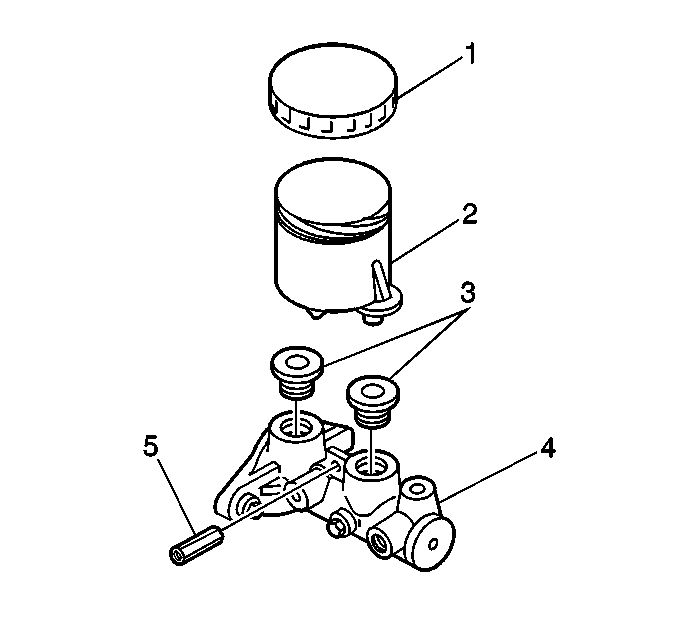

Caution: Do not place your fingers in front of the piston in order to catch or protect the piston while applying compressed air. This could result in serious injury.
Notice: Do not use lubricated compressed air on brake parts as damage to rubber components may result.
Important: DO NOT reuse piston cups.
Important: DO NOT use a cloth in order to dry the cylinder, because lint from a cloth will stick to the cylinder bore surfaces.
Assembly Procedure
- Install the spring to the master cylinder (2).
- Install the following to the master cylinder:
- Install the O-ring and the primary piston to the master cylinder.
- Install the plate.
- Install the new cylinder cup.
- Install the piston stopper.
- Depress and install the piston stopper snap ring into the master cylinder (2).
- With the pistons pushed entirely inside the cylinder, install the piston stopper bolt.
- Install the master cylinder to the brake booster. Refer to Master Cylinder Replacement .
- Apply a thin coat of brake fluid around the new grommets (3), and install the grommets to the master cylinder (4).
- Install the reservoir. Refer to Master Cylinder Reservoir Replacement .

| • | The new piston cup |
| • | The secondary piston assembly |
| • | The new secondary piston pressure cup |

Notice: Use the correct fastener in the correct location. Replacement fasteners must be the correct part number for that application. Fasteners requiring replacement or fasteners requiring the use of thread locking compound or sealant are identified in the service procedure. Do not use paints, lubricants, or corrosion inhibitors on fasteners or fastener joint surfaces unless specified. These coatings affect fastener torque and joint clamping force and may damage the fastener. Use the correct tightening sequence and specifications when installing fasteners in order to avoid damage to parts and systems.
Tighten
Tighten the stopper bolt to 10 N·m (88.5 lb in).

Master Cylinder Overhaul ABS
Disassembly Procedure
Caution: Brake fluid may irritate eyes and skin. In case of contact, take the
following actions:
• Eye contact--rinse thoroughly with water. • Skin contact--wash with soap and water. • If ingested--consult a physician immediately.
Caution: Use only Delco Supreme 11, GM P/N 12377967 (Canadian P/N 992667), or equivalent DOT 3 brake fluid from a clean, sealed container. Do not use fluid from an open container that may be contaminated with water. Improper or contaminated fluid could result in damage to components, or loss of braking, with possible injury.
Notice: When filling the master cylinder, use only Delco Supreme 11, GM P/N 12377967 (Canadian P/N 992667), or equivalent DOT 3 brake fluid. Do not use a container which has been used for petroleum based fluids, or a container which is wet with water. Petroleum based fluids will cause swelling and distortion of rubber parts in the hydraulic brake system, and water will mix with brake fluid, lowering the boiling point. Keep all fluid containers capped to prevent contamination.
Notice: Do not hone the master cylinder bore. When the brake master cylinder is overhauled, it is recommended that the cylinder body be replaced rather than CLEANED UP by honing the bore. The master cylinder has a hard, highly polished BEARINGIZED surface, which is produced by diamond boring followed by ball or roller burnishing under heavy pressure. Honing will destroy this hard smooth surface and cause rapid wear of the rubber cups.
Notice: Do not clamp on the master cylinder body. Doing so may damage the master cylinder.
- Remove the reservoir (2) from the master cylinder (4). Refer to Master Cylinder Reservoir Replacement .
- Remove the master cylinder from the booster. Refer to Master Cylinder Replacement .
- Remove the piston stopper snap ring (1) from the master cylinder (2).
- Remove the piston stopper.
- Remove the cylinder cup.
- Remove the plate.
- Pull the primary piston assembly carefully from the master cylinder in order to prevent damage to the inside of the cylinder wall.
- Remove the secondary piston assembly carefully from the master cylinder (1) by tapping the flange on a piece of wood (2) or two soft objects.
- Remove the secondary piston pressure cup.
- Remove the piston cup.
- Remove the O-ring.
- Inspect the components for wear or damage. Replace the components if necessary.
- Wash disassembled parts with brake fluid.
- Inspect the master cylinder bore for scoring or corrosion. Replace a damaged master cylinder.
- Rinse the cylinder in clean brake fluid. Shake excess rinsing fluid from the cylinder.


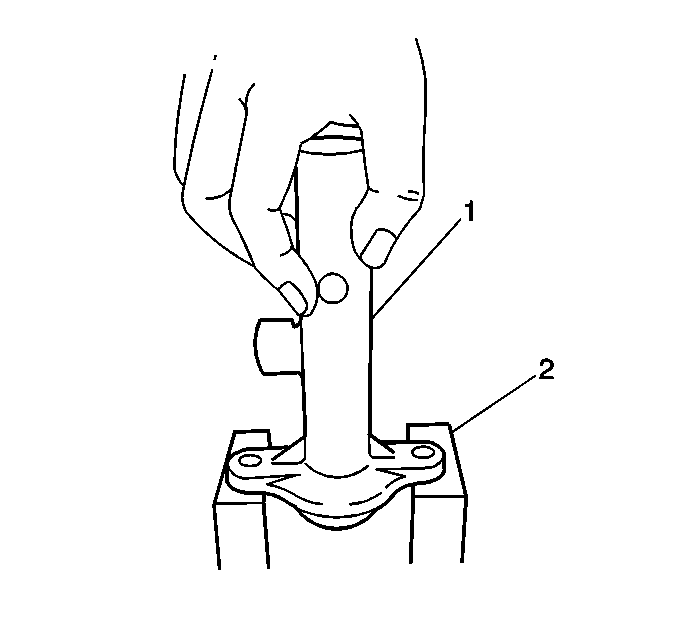
Important: DO NOT reuse piston cups.
Important: Do NOT use a cloth in order to dry the cylinder, because lint from a cloth will stick to the cylinder bore surfaces.
Assembly Procedure
- Install the O-ring to the master cylinder (2).
- Install the following to the master cylinder:
- Install the primary piston assembly to the master cylinder.
- Install the plate.
- Install the cylinder cup.
- Install the piston stopper.
- Depress and install the piston stopper snap ring into the master cylinder (2).
- Install the master cylinder to the brake booster. Refer to Master Cylinder Replacement .
- Apply a thin coat of brake fluid around the new grommets (3), and install the grommets to the master cylinder (4).
- Install the reservoir. Refer to Master Cylinder Reservoir Replacement .

| • | The new piston cup |
| • | The secondary piston assembly |
| • | The new secondary piston pressure cup |


